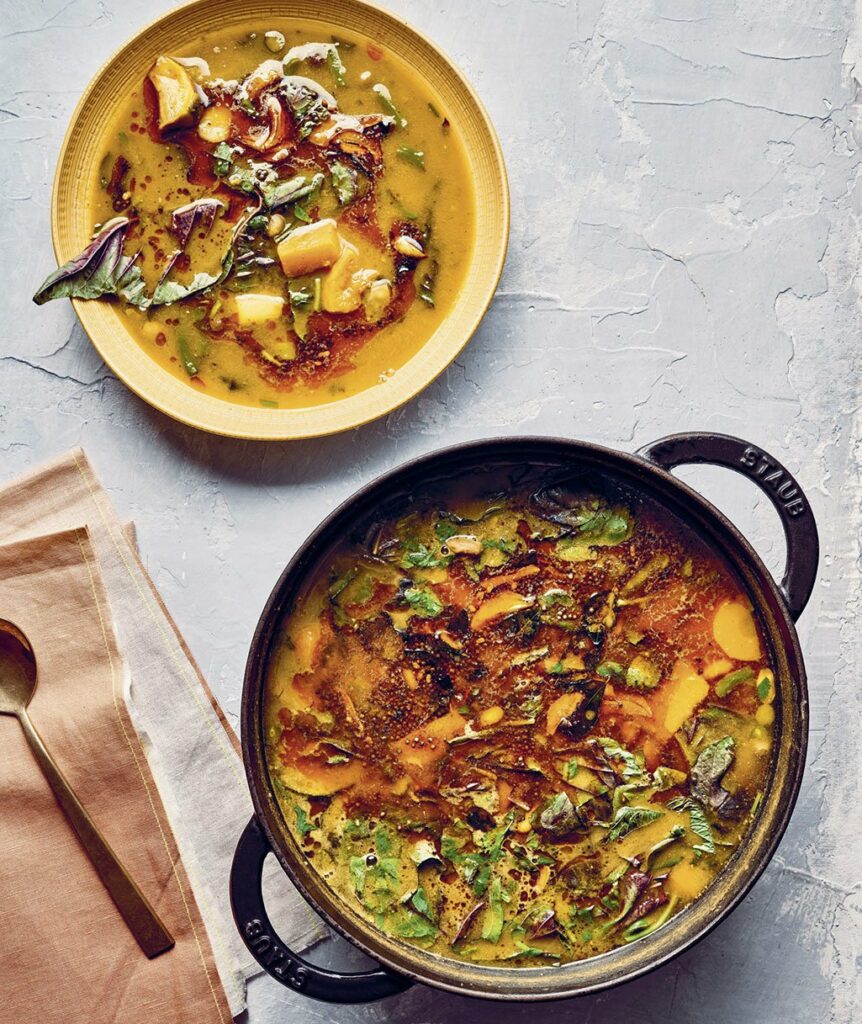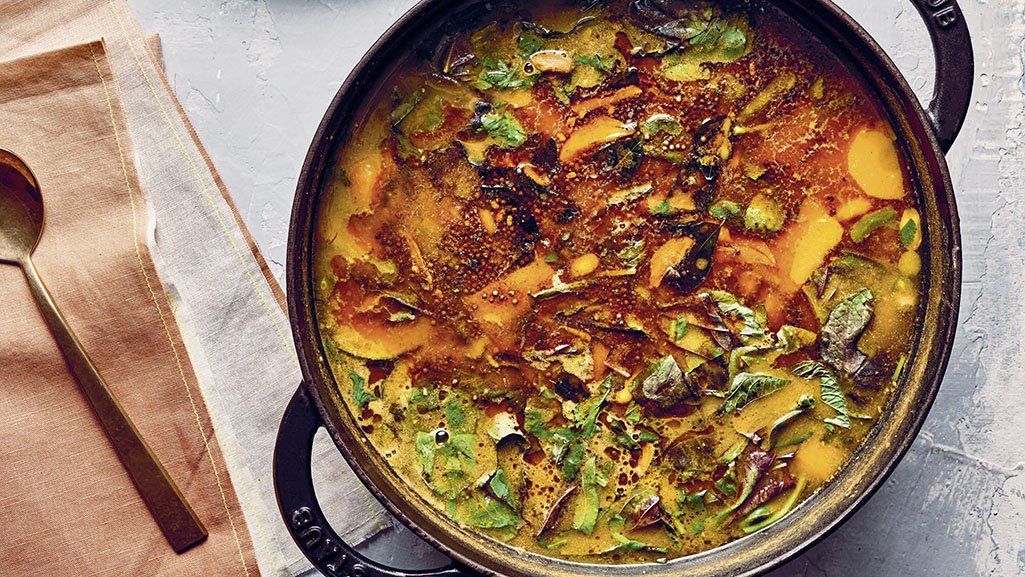 Out of the fifty or so lentils grown in India, toor dal, with its velvety consistency when pureed, is one of the best lentils to make soups with. Toor, in the pigeon pea family, is used as a base for the famous sambhar served with dosas in the south of India and for the simple aromatic Gujarati dal. This soup is a combination of the two, and no matter what time of the year, it serves as a wonderful vehicle for seasonal vegetables and greens. Enjoy this soup as a light lunch, a first course, or, more traditionally, with rice or roti.
Out of the fifty or so lentils grown in India, toor dal, with its velvety consistency when pureed, is one of the best lentils to make soups with. Toor, in the pigeon pea family, is used as a base for the famous sambhar served with dosas in the south of India and for the simple aromatic Gujarati dal. This soup is a combination of the two, and no matter what time of the year, it serves as a wonderful vehicle for seasonal vegetables and greens. Enjoy this soup as a light lunch, a first course, or, more traditionally, with rice or roti.
For the Ginger Puree (Makes About 1-1/2 cups)
1 pound ginger
About 1 cup water
Ginger is ground zero for most of my cooking; I use it in most preparations from savories to sweets. When buying ginger, seek out pieces with translucent and tender skin. If the only ginger available has thick brown skin, pick pieces with as few nubs and bruises as possible. Do not peel ginger—in India it is commonly believed that ginger’s maximum flavor lies just beneath the skin. Considered warming, cleansing, and stimulating, ginger has been regarded as medicine in Ayurveda and Chinese medicine for over five thousand years. Ginger is one of the most highly recommended aids for digestion, muscular pain, and constipation. Ginger juice mixed with honey is good for treating congestion and facilitates breathing by opening up wind passages.
Cut the ginger into 1/2-to 1-inch pieces—if any of the skin appears tough, slice it off and discard it, but otherwise leave the peel on. Pour the water into the bowl of a blender, then add the chopped ginger. Blend in short intervals, turning the mixture around with a spatula to get at all of it, until pureed. Store in an airtight container in the refrigerator, where it will keep for up to 2 weeks. Use the puree with the liquid unless specified otherwise.

Dal Soup
Ingredients
- 1 cup toor dal
- 1/2 teaspoon ground turmeric
- 3 or 4 whole cloves
- 2 teaspoons sea salt
- 2 tablespoons Ginger Puree (see recipe above)
- 2 cups seasonal vegetables cut into 1-inch cubes (such as butternut squash, zucchini, fennel, or carrots)
- 1 tablespoon jaggery
- 2 tablespoons whole peanuts (optional)
- 1/4 cup olive oil
- 8 small garlic cloves, sliced
- 1 teaspoon black mustard seeds
- 1/4 teaspoon fenugreek seeds
- 20 kari leaves
- 2 teaspoons red chile powder
- 2 cups chopped greens (such as spinach, watercress, or kale)
- 1/2 cup loosely chopped fresh herbs (such as cilantro, parsley, or basil)
- Juice of 1/2 lemon
Instructions
- Rinse the dal two or three times in cold tap water, add water to cover by a couple of inches, and soak for 5 to 6 hours. Drain.
- In a large saucepan, combine the drained dal with 4 cups water and bring to a boil over high heat. Discard any scum that may arise—scum contains impurities that can make lentils and beans hard to digest. (Alternatively, drain the dal, add 4 cups fresh water, and bring to a boil again.) Add the turmeric, cloves, and salt and bring to a boil. Lower the heat to low, cover the pot, and simmer for about 1 hour, checking every 15 to 20 minutes to make sure the water has not evaporated. The dal are done when they are cooked to a soft, fall-apart doneness; it’s better to err toward overcooking than undercooking.
- Toward the end of cooking, blend the dal into a smooth puree using a whisk or an immersion blender. The consistency should be fairly soupy— it will thicken after you add the vegetables. Add the ginger puree, cubed vegetables, jaggery, and peanuts (if using) and cook, covered, for 10 minutes, or until the vegetables are soft but hold their shape.
- When ready to serve the soup, in a small frying pan, heat the oil over high heat and add the garlic. Cook for a few seconds, until the garlic has turned light golden brown, then pop the mustard seeds and fenugreek seeds. Turn the heat off, add the kari leaves and red chile powder, and pour this mixture into the dal and simmer for 2 to 3 minutes, or until incorporated. Just before serving, stir in the greens until wilted, then add the herbs and lemon juice.VariationsInstead of mustard seeds, try a cumin seed or fennel seed pop.Instead of using garlic, try a pinch of asafetida just before adding the mustard seeds and fenugreek seeds.When in season, add 2 cups diced fresh tomatoes after you turn the heat off and stir until the tomatoes soften but still hold their shape.Add 1 cup diced green or unripe mango to the dal along with the other vegetables.
Notes
 Reprinted with permission from Masala: Recipes from India, the Land of Spices by Anita Jaisinghani, copyright © 2022. Published by Ten Speed Press, an imprint of Penguin Random House. Photographs copyright © 2022 by Johnny Autry. Illustrations copyright © 2022 by Julie Keselman.
Reprinted with permission from Masala: Recipes from India, the Land of Spices by Anita Jaisinghani, copyright © 2022. Published by Ten Speed Press, an imprint of Penguin Random House. Photographs copyright © 2022 by Johnny Autry. Illustrations copyright © 2022 by Julie Keselman.

